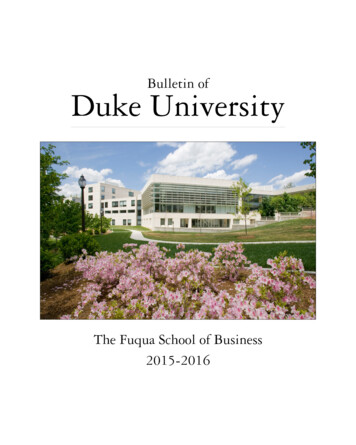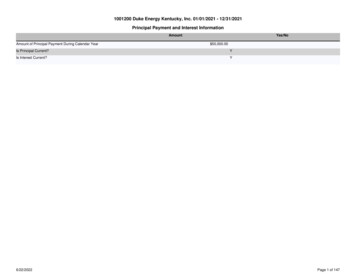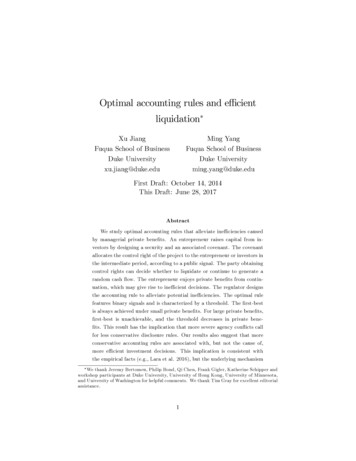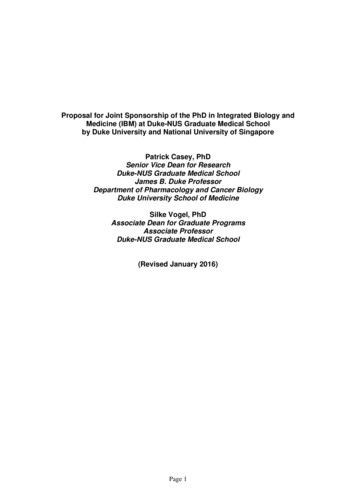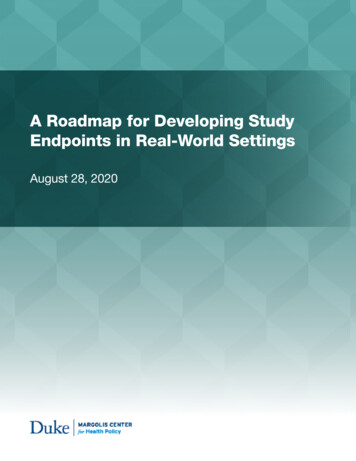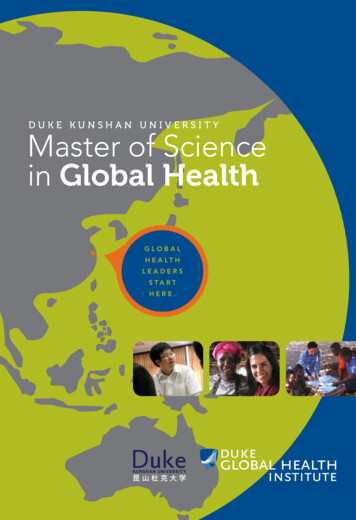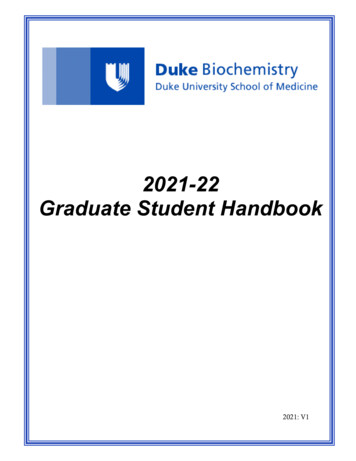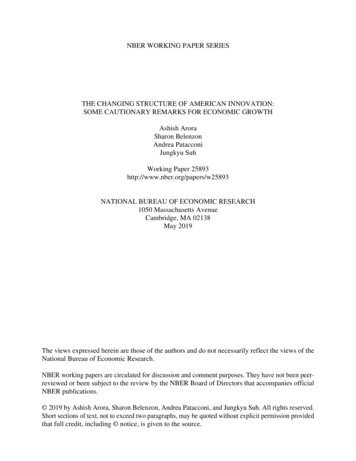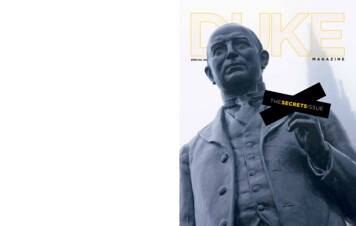
Transcription
MAGAZINEDUKE UNIVERSITY, BOX 90572DURHAM, NORTH CAROLINA 27708-0572DUKE MAGAZINE SPECIAL ISSUE 2017DUKENONPROFIT ORG.U.S. POSTAGEPAIDPPCOM AG A Z I N ESPECIAL ISSUE 2017THESEWhose home is this?For the Duke graduate who lived here, it was a placewhere all that was collected served as inspiration andhomage, and perhaps for visitors, as revelation.Learn the answer and see more, beginning on page 38.Photos by Alex HarrisC R E TSI SS U E
Outrageous ambitionClimate change. Energy. Medicine. At Duke, engineeringstudents like Lauren Shum ’17 tackle big challengeshead on. Thanks to a planned gift supporting financialaid at the Pratt School of Engineering, we can recruitmore students based on their ambition to change theworld, rather than their ability to pay.Made possible by you.Grand ChallengeScholar andfinancial aid recipientLauren Shum ’17wants to make solarenergy economical.Together with fellowDuke Smart Homestudents, she designedand installed the solarcharging station ona swinging bench byMcClendon Bridge.This bright idea givesstudents a sustainablelight and power source.Read about alumnusChun Lam’s plannedgift to benefitengineering studentson page 76.Whether you leave a legacy with a planned gift or make an immediate impact with anAnnual Fund donation, every dollar makes a difference. Together, we are generating themeans for the next generation of Duke students and faculty to advance ideas, make newconnections, and move the world forward. giving.duke.edu/giftplanning (919) 681-0464
SPECIALISSUEA collection of essays and images from Duke faculty, students, staff, and alumni4FROM THE EDITORAre your secrets safe with Duke?By Robert J. Bliwise6 SecretsBut howdo you get fromblues to rock androll? And whereare the musiciansIn all of this?MeetChuckBerry 1926–Ida Red, sheain’t no fool.She could ridea’straddle Of amule.humpbackButIhan n Berry’dsbec , that same Oh MaybellEne,Why can’t yoube true? Who listenedto blues andcountry, andtook fromboth ONepsul keROLLMy so ’ The blues,singinhoven, Tellover BeetTchaikovskythenews!And across theAtlantic, someoneelse was listening I say It again,there arethousandS OFprinces, but onlyone Beethoven!!CONTRIBUTORS:You think you’vegot It bad.Imagine being“the artistformerly knownas Beethoven”!Hey, did you hearmy cover ofJohnny B.Goode?*Roll overBeethoven Roll overBeethoven ALUMNI: Siobhan Darrow ’81; Bev Darwin ’83, M.D. ’86; Andy Frankenberger ’95;Rob Goodman ’05; Sue Gordon ’80; Peter Hellman ’64; Mark Mazzetti ’96;Viola Minicozzi Dwyer M.B.A. ’11; Johanna McCloy ’86; Wyndee Parker ’91;Michael Ruhlman ’85; Lynn Saville ’71; Jimmy Soni ’07; Ursula Werner ’85;Ryan White ’04; Craig Whitlock ’90STUDENTS: Bill McCarthy, Patrick Thomas Morgan, Jake Parker, Nina Wilder*Prince: If you haven’t listened to him, you should. RIP -Eds.134 Ph.D. ’98; Jana Shaich Borg; James Boyle; Peter Feaver;FACULTY: Dan ArielySarah E. Gaither; Alex Harris; Jennifer Jenkins A.M. ’00, J.D. ’97;Alex Roland Ph.D. ’74; Margaret SartorCOVER: In these daysof cancer warningsand secondhandobjectors, even JamesB. Duke might haveto be a closet cigarsmoker. Photo byChris HildrethSTAFF: Jimmie Banks, Saskia Cornes, Christina Holder M.Div. ’13, Jason Stein74ForeverDukeIn MemoriamDUKEMAGAZINE.duke.eduwww.DUKE MAGAZINE SPECIAL ISSUE 2017 Vol. 103 No. 3EDITOR: Robert J. Bliwise A.M. ’88 MANAGING EDITOR: Adrienne Johnson Martin SENIOR WRITER: Scott Huler CLAY FELKER STAFF WRITER: Lucas Hubbard ’14 CONTRIBUTING EDITORS:Michael Penn and Christina Holder M.Div. ’13 STAFF ASSISTANT: Delecia Hatcher PUBLISHER: Sterly L. Wilder ’83, associate vice president, Alumni Affairs SPECIAL SECTIONS EDITOR: Bridgette LacyART DIRECTOR: Lacey Chylack, phase5creative, inc. PRINTER: Progress Printing OFFICERS, DUKE ALUMNI ASSOCIATION: Jack Boyd ’85, president, Sterly L. Wilder ’83, secretary-treasurer DUKEMAGAZINE Box 90572, Durham, N.C. 27708 PHONE: (919) 684-5114 FAX: (919) 681-1659 E-MAIL: dukemag@duke.edu ADDRESS CHANGES: Alumni Records, Box 90581, Durham, N.C. 27708 orbluedevil@duke.edu 2017 Duke University, Published five times a year by the Duke Alumni Association.
HIDE&SECRETI SEE YOU: On this summer day, "The Big Easy," the Patrick Dougherty sculpture that sits onthe south lawn of the Sarah P. Duke Gardens, provides an ideal place to get lost—and found.Photo by Chris Hildreth
F R O MTHEED ITORAre your secrets safe with Duke? As we started our conversation in anoff-campus Duke building that canfairly be described as nondescript(nondescript but with the indescribable advantage of a Whole Foods nextdoor), Holly Benton was immediately taken by this issue’stheme of secrets. The daily headlines are dominated, after all,by speculations and revelations rooted in secrets, by the contest—playing out in the political landscape—between embedding and uncovering secrets.We were meeting just outside her office, in the building’sconference room; on a huge whiteboard, somebody hadsketched the university’s organization chart. Benton had herown starting question, which was basically: “How did youfind out about me?” It’s not that there’s anything secret abouther role as the chief privacy-compliance officer in the Officeof Audit, Risk, and Compliance. Still, in the vast Duke universe, her area might not seem to be an attention-grabber.Which is ironic, given the amount of personal data scoopedup by Duke. That and the growing awareness around howmuch information we share, and how many avenues there arefor that information to be compromised.Duke and other universities have been grappling for sometime with issues around privacy, particularly issues connectedwith the rather inelegant acronyms of HIPAA and FERPA—the Health Insurance Portability and Accountability Act,geared to protecting individual medical information, and theFamily Educational Rights and Privacy Act, which governsthe release of student education records. (Benton noted thatEuropeans have a codified right to privacy; that’s not the casein the U.S.) And Duke’s technology offices offer privacy-driven guidance and services that point to their ever-growingtech prowess—vulnerability scanning, antivirus and malwareprotection, password management, data-loss protection, andmuch more.But a centralized role like Benton’s is relatively new in higher education. Two years ago, when she joined Duke, the privacy-officer role was exclusively HIPAA-focused. Today therole is more comprehensive.Benton’s own trajectory says a lot about her approach tosafeguarding individual secrets. She has a law-school andlegal-practice background; had the field then existed, shewould have concentrated in privacy law. Before that, she wasin graduate school intending to earn (though not completing) a Ph.D. in women’s studies. Her focus was on how peo-4 www.dukemagazine.duke.eduBy Robert J. Bliwiseple use their bodies as texts—that is, how they choose to present themselves to the world, perhaps through body piercings,and in turn how they’re perceived by the world.Now, of course, people present themselves to the world inways that they may or may not choose, in ways they may ormay not think deeply about, and with potentially profoundconsequences. Consider a different university’s decision to revoke the admission offers of students who, via their Facebookchat group, had posted offensive remarks. That episode illustrates, Benton said, that we have to perceive of ourselves asbeing, in essence, divided: a physical self and an informationself. We’ve long been accustomed to tending to our physicalselves. Now we’re learning to be mindful of our informationselves—a painful lesson for those rejected students.But mindfulness is a process; it’s not automatic. Valuingour secrets doesn’t necessarily translate into guarding our secrets. As Benton put it, “Privacy doesn’t matter until it matters,” and not just in the fraught realm of college admissions.She serves up an example of how we regularly make choicesto “commodify our own privacy”: ordering a burrito on yourphone, downloading an app, clicking on a statement that youagree to specified terms and conditions—and so “there goesevery aspect of your personal data, but you may do that in aheartbeat, because you’re hungry.”A complex place like Duke, she told me, increasingly thinksof the reams of personal information as assets—almost likemonetized assets requiring careful stewardship. That meansit’s important to include privacy protection in any data-gathering effort involving, say, alumni, just as it’s a basic step tosecurely lock files with the identities of clinical-trial subjects.In a larger sense, it means asking the “what” and “why”questions around the institution: What personal informationdo we have, and why do we have it? “Remember when collegeID cards included Social Security numbers? Well, today wemight have a need for Social Security numbers so that, forexample, we’re not confusing the records for students withthe same name. We don’t necessarily need the entire number.Let’s just keep—and so have responsibility for—protectingwhat we need to have.”Universities are traditional stewards of knowledge. They’realso stewards of an enormous amount of personal information—student, faculty and staff, alumni, patient, research-subject information. In our effortlessly connectedworld, we can only hope they remain zealously committed tothat task of stewardship. nLes Todd
Why we tell By Dan ArielyOne of the interesting thingsabout secrets is that weshare them, expecting thepeople we share them withto not share them further—and then those peo-people will then tell us that our behavior was actuallyokay. The tradeoff comes when we trade secrecy for thehope of reassurance. That’s the first seeming mystery ofsecrets: why we share them to start with.The second question is, Those other people we tell thesecrets to, why do they betray our confidence and shareple do share them further.them further? They actually do that to advance their status in a social hierarchy.So the first question we need to ask is, Why do people share secrets? If they’re things we don’t want peopleImagine that we have three people: person A, personto know, why do we share them? We don’t share all seB, and person C.crets, but what sharing secrets represents is a tradeoff: aPerson A tells a secret to person B, asking them totradeoff between social acceptance and the desire to keepkeep it a secret. Then person B tells it to person C. Inour less-than-holy behavior private.that act of violating the promise—saying, “Hey, I haveWhen we behave badly, we feel negatively about it.a secret that person A told me, and I promised him notWe are embarrassed, we feel bad, we feel shame, we feelto tell, but I’m telling you”—in that action of revealingguilty. So we don’t want anyone to know what we’vea secret, person B is actually saying something to persondone, but at the same time, at some level, we want to beC. “I know something about person A,” he is saying.forgiven. We want to be told that this is actually okay,“But you, person C, are more important to me than person A, so I’m willing to violate their trust in order forthat it’s not too bad, that other people behave this way asyou to get that piece of information.”well. And we can’t get this social recognition that this behavior is actually okay, that it’s not that bad, if we don’tWe tell secrets for two reasons. First, we tell our personal secrets because we crave reassurance, and in theshare it with anybody.pursuit of reassurance we share shameful secrets andOften people think we share to unload a burden. Buttrust our friends. But second, in the pursuit of improvedthe reality is that we share secrets because we want to bestanding in the social hierarchy, the recipients of our setold that we’re actually okay, that this behavior that we’recrets sometimes, maybe too often, betray us.embarrassed about or think badly about is actually notSo the two mysteries of secrets—why we tell themthat bad.from the beginning, and why theSo secrets are things that we’reAriely Ph.D.’98 is the James B.people with whom we share themembarrassed about, which causes usDuke professor of psychology andshare them, then share them furthernot to want to share them with other people, but they also make us feelbehavioral economics, and theon—I hope are slightly more clear.bad, which makes us want to sharefounder of the Center for AdvancedAnd now let me tell you a secret.them with people—as long as thoseHindsight at Duke.You know what? Maybe not. nLacey ChylackDUKE MAGAZINESPECIAL ISSUE 20177
Code-making and code-breaking TPROGRESS: Center, Poznań monument to Polish cryptologists whose breaking of Germany's Enigmamachine ciphers, beginning in 1932, altered the course of World War II8 www.dukemagazine.duke.eduBy Ziko, via Wikimedia CommonsBy Rob Goodman and Jimmy Sonihe hacking of the 2016 American elecient, and no one else, could make sense of it? In one famoustion. The WannaCry ransomware atexample of “software,” American leaders recruited Navajo Inditack on Britain’s National Health Serans to transmit coded messages because their native tongue wasvice. The penetration of 500 millioncomplex enough—and unfamiliar enough—to evade detectionYahoo accounts. The story of modernby the Axis powers. The hardware was some of the most advanced computing of its day—huge, room-sized machines thatsecrets is, in part, the story of the technology that protects them (or fails to). It’s the story of encryptook ordinary messages and transfigured them into undeciphertion, computer science, and cryptology, of the ever-increasingable sequences of numbers, symbols, spaces, and letters.complexity of algorithms designed to shield information fromWhy should this history of top-secret-keeping matter to usprying eyes—and, seemingly inevitably, of their failure.today? For one thing, it helps us recognize that our modernThese technologies can seem unique to our time and place,struggle of information security has some important historicalmodern threats created by modern tech. But they have deantecedents. In appreciating that history, we can also come tocades-old origins. And, ironicallybetter understand the early pioneers whoenough, it was the quest to control thedid this work and saved lives in the process, names like Alan Turing and Claudeflow of wartime information in theShannon.twentieth century that gave rise to theTheir stories provide powerful examenormous expansion of access to information represented by the modernples of academic mathematicians divingInternet—and, in turn, to the secreinto practical, hard-headed work—workcy-compromising developments thatthat inspired important contributions tohave recently dominated the headlines.technology and computer engineering.It was during World War II thatAt the same time as they were draftedmany of the world’s leading minds ininto cryptography on either side of theMATH MEN: American cryptographersmathematics and early computing putAtlantic, Alan Turing and Claude ShanClaude Shannon, left, and Alan Turingnon were writing long theoretical paperstheir work to the side and signed up toabout communication, the foundationshelp make and break codes. Wartimeof thinking machines, and much else. Turing’s work on breakpresented them with an urgent set of challenges: how to sending Germany’s Enigma code helped lay the foundations of modsecure messages across vast oceans, how to decode complex enemy correspondence, and how to do all of that as quickly asern computing. Shannon, for his part, confessed that he didn’tpossible and with lives in the balance.particularly enjoy cryptography—but he did it, and concededOne tragic story illustrates the gravity of the work. On thethat it led to a great “flow of ideas back and forth,” between hismorning of December 7, 1941, George Marshall, the Army’swartime work and his seminal paper on information theory,chief of staff, had an important message for his Pacific Comwhich became the intellectual architecture behind the Internet.mand: Japan had determined that it could no longer mediateThe safeguarding of secrets, in other words, wasn’t only a vitalits differences with the United States through politics. War waswartime imperative. In the process of thinking deeply aboutlikely. But how best to transmit this information? Marshall couldsecrecy, Turing, Shannon, and other early computer scientistshave used the trans-Pacific telephone—but this was an insecureinaugurated the Information Age. Thanks to their work, thesystem. So he used the slower, but more secure, commercial raInternet offers us nearly the sum of human knowledge at thedio telegraph. The message arrived just after the attack on Pearlclick of a mouse—as well as a not-entirely-secure home for ourHarbor was over. The near destruction ofown secrets. Their legacies remind usGoodman ’05 and Soni ’07 are the cothe Pacific Fleet was, among much else, athat the race between code-makingauthors of two books: Rome’s Last Citiwake-up call to America’s code writers.and code-breaking is never done—zen and A Mind at Play: How ClaudeCryptology was a software and hardwareand that the pursuit of secrecy hasShannon Invented the Information Age,problem. The “software” was language—long been one of the most powerfulpublished by Simon & Schuster in July.how to deliver a message so that the recipdrivers of technological progress. nWikipediaDUKE MAGAZINESPECIAL ISSUE 20179
Walden Pond in Kunshan By Patrick Thomas MorganWhenever I tell people that I traveled to Dukewith the help of the 1917 Vernacular Writing Movement.Kunshan University to teach a course aboutImagine growing up in China during the first half of the twentieth century and realizing that this laowai—this foreigner—Henry David Thoreau and China, I oftenfrom another continent and a previous century, is no foreignerreceive a bemused look and a response thatat all, but decidedly familiar, resonating with the voices of yourgoes something like this: “Thoreau seems so quintessentiallycountry’s great writers.American. How could you possibly relate him to China, let aloneIn class, whenever we came across a Confucian quotation inenergize twenty-first-century Chinese students to study him?”Walden, students would excitedly provide the original ChineseAlthough Thoreau never physically traveled beyond Northwords before sharing their own English translations, pointingAmerica, he often sauntered intellectually across the Celestialout, in the process, any faults in Thoreau’s rendering. They oftenEmpire. He admired, for instance, the practicality of Confuciandidn’t agree with Thoreau’s version, which makes sense becausephilosophy. In an 1856 letter, he writes how Confucius “is fullThoreau was translating from a French text, meaning his own Enof wisdom applied to human relations,—to the private life,—glish translations were two steps removed from the original Chithe family,—government, etc.” This admiration was so strongnese. During these translation moments, my students learnedthat Thoreau helped introduce Chinese thought to America,what it means to have a voice in the classroom. They often toldselecting passages from Chinese literature for the “Ethnicalme that, thus far, their Chinese education had taught them onlyScriptures” section of The Dial, the major magazine of American Transcendentalism.to be silent in the classroom. It felt as if Thoreau was enkindlingIndeed, some scholars even argue that Chinese thought proin them a new sense of agency and freedom of thought, sharingvided Thoreau justification for his two-year experiment livinghis keen sense of critique, while radically changing their academic mode of being.along the shores of Walden Pond. In one of his translations,The most compelling way to connect my students with WaldenThoreau recounts how a Confucian disciple named Tian answers the question: What would you do if you became famous?was to bring them to Walden Pond. The summer before I left forTian says that he would travel to the river Y, bathe in its waters,China, I traveled to Concord, Massachusetts, making a daily trekbreathe the fresh air of the woods, and return home. Thoreauto the shores of Walden Pond, taking a series of videos replicatingends this story by inserting himself into the narrative: “For thethe objects and movements-through-space Thoreau describes inmost part I too am of the opinion of Tian.” The beginninghis book. I created a digital field-trip course website in which theof Walden frames Thoreau’s life using a similar trajectory: Hetext of Walden is provided with hyperlinks to videos illustratinglived in the woods near a body of water before returning as “athe areas, objects, and phenomena Thoreau references.sojourner in civilized life again.”Nothing enlivens students’ sense of the living author moreWalden intricately resonates with Chinese history. The yearthan transporting them—even digitally—to the place where1949 marks both the Chinese Revolution and a literary mileHenry David Thoreau was fully alive. By the end of the course,stone: the publication in Shanghai of the first Chinese translastudents had created their own videos called Walden Pond intion of Walden. Thoreau’s words seemed familiar to my students,Kunshan, using passages from Thoreau’s book to describe theoften leading them to compare him to Chinese poets both anChinese landscape, and leaving us—as a learning community—cient and modern. This resonance led the writer Lin Yutang towith the opposite question to the one I so often get from others:argue in 1937: “Thoreau is the most Chinese of all American auHow could you possibly not relate Thoreau to China? Such athors in his entire view of life, and being a Chinese, I feel muchconnection between Thoreau and China began in the nineteenthakin to him in spirit.”century, with Thoreau helping to introduce Chinese thought toThe country’s discovery of ThoreauAmerica; by 1949, Chinese readers wereMorgan specializes in nineteenth-centurycoincides nicely with the rise of lyricalexperiencing Thoreau’s Walden in its entirety; and now, in the twenty-first-cenAmerican literature as an English Ph.D.prose (sanwen), a genre that gives voicetury classroom at Duke Kunshan Unicandidate at Duke. He’s also the editorialto personal experience and emotionalversity, students are revising Thoreau’sassistant for the journal Americaninflection. Although lyrical prose hadwords to express their own relation toLiterature and taught a course earlier thisbeen around for centuries in China,it only became the preeminent genre summer, “The Great American Short Story.” the land and their country. nDUKE MAGAZINESPECIAL ISSUE 201711
It’s all a bluff TBy Andy Frankenbergerwo players remained at the 2012 WorldSunglasses are, on the margin, a sign of weakness, not strength.Series of Poker 10,000 Pot LimitWhen I’m playing my best and feeling confident, I want myHold’em Championship: Phil Ivey,opponents to see that confidence in my eyes. Confidence iswidely regarded as the best poker playerscary at the poker table, and players tend to avoid confrontations with confident, competent players. But what do I do ifin the world, and me, an equity derivatives trading veteran who only recentlyI’m playing against the best poker player in the world and I’mhad become a professional poker player. At stake: a first-placenot feeling particularly confident? This is where sunglasses canpayout of 446,000 and a World Series of Poker gold bracelet,help. Early on at the Final table with Ivey, I tried to suppress myrepresenting the most prestigious title in the poker world. I wasjitters by wearing the most opaque sunglasses I could find. Theplaying for my second bracelet, while Ivey was playing for hisreality that I couldn’t see as well with them on was a small priceninth, the second most of any poker player in history.to pay for the benefit of hiding my fear. Once I put on thoseI had just made a semi-bluff into a huge pot, putting Ivey inglasses, I took solace in knowing my opponents couldn’t see mya difficult decision that would likely determine the tournamenteyes, and I could fake my confidence until I found it. One bywinner. He sat twelve feet away, his eyes laser focused on mine.one, players were eliminated until, at last, I found myself in aIf I showed weakness in any way—an exaggerated swallow, anpoker player’s dream scenario, heads up against Phil Ivey, playing for a championship bracelet.unnatural blinking pattern, an accelerated pulse in my carotidThe stadium filled as a record crowd gathered to watch Iveyartery—he’d see right through me.play for bracelet number nine.But I’m not swallowing, myDespite the stakes, I felt likepulse is normal, and when Iblink, I blink with purpose and Ivey’s terrifying stare lasts several minutes. I was playing with nothing tolose; there was no shame, afterconfidence. Ivey is known forall, in losing to the best pokerhis intimidating stare, so I avoidplayer in the world, and I was already guaranteed to receiveeye contact and focus my stare at the cards in front of me. Can hemore than 275,000 for second place. My fear turned to consee right through me—does he know that all I have is King-high?fidence and excitement as I embraced the role of underdog andOr is he afraid of the confidence in my eyes and believes I have KJremoved my sunglasses for the heads up battle.(King/Jack) for the best possible hand—the Broadway straight?Back to the pivotal hand. Ivey’s terrifying stare lasts severalThe two most common questions people ask me as a professional poker player are 1) do I count cards? and 2) do I wearminutes. He eventually calls my semi-bluff on the turn. Whensunglasses? The answer to the first question, as any poker playerthe final card flips and my King-high does not improve, I fearunderstands, is no—card counting is a blackjack strategy andfor the worst. I check and Ivey goes back into his stare. I lookdoesn’t really apply to poker. Poker is the ultimate intellectualstraight ahead with as much confidence as I can muster, knowing that if he places even a small bet I will likely have to fold.game, and the type of analytical thinking I do at the poker tableBut Ivey eventually checks back and mucks in disgust when heis very similar to the type of thinking I did as an equity derivatives trader for fourteen years. Bluffing, posturing, reading yoursees I was bluffing with the best hand!opponents—these all play a part in the game, but at its core,After this hand (where Ivey must have missed a big draw), I waspoker requires you to calmly and methodically make timely,able to hold on for a victory that no one, not even I, would havecalculated decisions in the face of uncertainty and risk. Whichpredicted. While I wouldn’t say the sunglasses were the reason Ibrings me to the second question aboutwon, they certainly proved a useful tool (asFrankenberger ’95 is a two-timesunglasses. Yes, I wear them on occasion,did their absence during this crucial hand).World Series of Poker Champion, abut not for the reasons you might think. INext time you see a poker player at theformer World Poker Tour Player ofdon’t wear them because I’m trying to hidetable wearing sunglasses, don’t be intimidated by that stoic facade. See the sunglassesthe Year, and a former equity derivthe strength of my hand or because I’m trying to be tricky. I’ll reveal something pokeratives trader. Follow him on Twitterfor what they are—a sign of fear. And pleaseplayers might not even admit to themselves:@AMFrankenberger.don’t mention that I told you so. nDUKE MAGAZINESPECIAL ISSUE 201713
HIDDEN PLEASURE: Banks’ portraits include, clockwise from top left, former Duke president Richard H.Brodhead and his wife, Cindy; and scenes from thefilms Black Belt Jones, Fight Club, and Sparkle.The drawing callsJimmie Banks’ first job as an electrician at Duke involved changinglightbulbs in the chapel—loweringthe chandeliers weekly to replace anythat had burned out. It came naturally,since he had spent a few years beforethat working for a Raleigh companythat changed factory light bulbs. He’dbeen a cook, too, and he’d wired upmobile homes and laid down underground wires and fiber-optic cables.But when he sits in the Bryan Centertaking a break and seemingly everythird person stops by to chat, nobody’stalking about light bulbs or cable oritems on his work list. What they liketo talk to Banks about is his first andforever love: his art. n“Can’t wait to get to break.Get a little breather.Get a little rest.And draw a little picture.”14 www.dukemagazine.duke.eduPhoto by Alex Boerner
A public conversation Edited by Robert J. Bliwise“Secrets Protected, Secrets Exposed: The Balancing Act inOur Democracy” was the theme that drew alumni and others for a DukeMagazine event this past spring in a secrecy-minded place—Washington, D.C.The event centered on a discussion among alumni on both sides of the longrunning debate about whether and how information should be withheld ormade public in a free society: Sue Gordon ’80, deputy director of the NationalGeospatial-Intelligence Agency, who also had a long stint with the CIA; MarkMazzetti ’96, Washington investigations editor for The New York Times andauthor of The Way of the Knife, about the secret wars waged by the CIA andPentagon; Wyndee Parker ’91, national-security adviser to the Office of theDemocratic Leader of the House of Representatives, and a one-time attorneyat the CIA and FBI; and Craig Whitlock ’90, investigative reporter for TheWashington Post, who has reported from more than sixty countries. The moderatorwas Peter Feaver, a Duke political science and public policy professor anddirector of the Duke Program in American Grand Strategy, who formerly workedon the staff of the White House National Security Council. Here’s an editedversion of the conversation.16 www.dukemagazine.duke.eduDUKE MAGAZINESPECIAL ISSUE 201717
FEAVER: What is it about this issue that you wishmembers of the government understood andacknowledged?WHITLOCK: One thing is the degree to whi
DUKE MAGAZINE DUKE UNIVERSITY, BOX 90572 DURHAM, NORTH CAROLINA 27708-0572 NONPROFIT ORG. U.S. POSTAGE PAID PPCO MAGAZINE DUKE MAGAZINE SPECIAL ISSUE 2017 SPECIAL ISSUE 2017 Whose home is this? For the Duke graduate who lived here, it was a place where all that was collected served as inspiration and homage, and perhaps for visitors, as .
